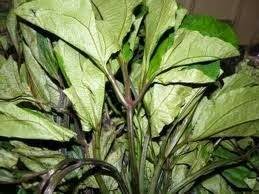The Latin name is (Telfairia Occidentalis). The Igbo people of Nigeria and most Nigerians call it Ugu. The Ghana people call it Krobonko, while people from Sierra Leone call it Gonugbe. The English name is Fluted pumpkin, fluted gourd and the Spaniards call it Costillada.
This vegetable is used a lot in Nigeria to cook soups (what you may refer to as a sauce), to boil and eat plain, or to blend into a shake.
The scientific name is Telfairia Occidentalis leaf.
Telfairia Occidentalis is a tropical vine grown in West Africa as a leaf vegetable and for its edible seeds. Common names for the plant include Fluted gourd, Fluted pumpkin, and Ugu.
Telfairia occidentalis is an important staple vegetable grown in Nigeria. The plant produces luxuriant edible green leaves, which are rich in iron and vitamins. Stems of the plants have branching, long twisting tendrils and the leaves are divided into three to five leaflets with the terminal leaflets up to 15 cm long, while the male plant is grown principally for leaves and seeds, which are important soup condition.
Harvesting of fluted pumpkin takes place 120-150 days after sowing
Prevent Convulsion: The young leaves sliced and mixed with coconut water and salt are stored in a bottle and used for the treatment of convulsion in ethno medicine.
Lower Cholesterol: Telfairia occidentalis leaves has hypolipdemic effect and may be a useful therapy in hypercholestolemia.
Boost Fertility: A particular study showed that Telfairia occidentalis has the potential to regenerate testicular damage and also increase spermatogenesis.
Prevents Liver Damage: It has a liver protecting effects.It has antibacterial effects
Blood Forming Effect: the leaves are rich in iron and play a key role in the cure of anaemia, (my mother used to mix the leaf extract with milk)
they are also noted for lactating properties and are in high demand for nursing mothers.
Good For Diabetics: It has an hypoglycaemic (sugar reducing) effect. It is good for diabetics
Increases Blood Volume and Boost Immune System
The high protein content in leaves of plants such as Telfairia occidentalis could have supplementary effect for the daily protein requirement of the body.
Chemical Constituents
Telfairia occidentalis leaf is rich in minerals (such as iron, potassium, sodium, phosphorus, calcium and magnesium), antioxidants, vitamins such as thiamine, riboflavin, nicotinamide and ascorbic acid
phyto-chemicals such as phenols.
The leaves contain essential oils.
The amino acid profile of Telfairia occidentalis had also been shown to be very rich and includes alanine, aspartate, glycine, glutamine, histidine, lysine, methionine, tryptophan, cystine, leucine, arginine, serine, threonine, phenylalanine, valine, tyrosine and isoleucine
(adsbygoogle = window.adsbygoogle || []).push({});

.jpg)
